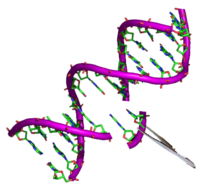
Photo from wikipedia
In recent years, CRISPR/Cas9 has been used to efficiently edit the genomes of embryos in many animal models. Due to smaller anatomy, lower costs, and multiple ovulations, it is relatively… Click to show full abstract
In recent years, CRISPR/Cas9 has been used to efficiently edit the genomes of embryos in many animal models. Due to smaller anatomy, lower costs, and multiple ovulations, it is relatively simple to derive large numbers of in vivo fertilized zygotes for gene editing experiments in small mammal models. In cattle, however, harvesting in vivo fertilized zygotes generally requires a highly invasive surgical procedure. Here, we use the combination of a minimally invasive endoscopic method for harvesting in vivo fertilized zygotes by oviductal flushing of superovulated heifers and the subsequent electroporation of zygotes with CRISPR/Cas9 ribonucleoproteins (RNP). After superstimulation of 21 heifers, on average 12 zygotes were flushed per animal with fetal bovine serum, then stored in synthetic oviductal fluid (SOFaa) before electroporation. Targeting exon 1 of the tyrosinase (Tyr) gene, zygotes were electroporated in 1-mm gap cuvettes (Biorad) in groups of ~20 in 20 μL of OptiMEM media containing 3 μM Cas9 RNP (IDT Cas9 protein pre-incubated with anti-Tyr guide RNA). Electroporation was performed in 3 replicates of 3 electrical potentials, namely 20, 25, and 30 V using a Biojet CF 50. The other electroporation parameters were fixed at 5 repetitions of 2-ms square wave pulses at 100-ms intervals. The zygotes were than cultured under standard embryo culture conditions (SOFaa + 0.3% bovine serum albumin, 5% CO2, 5% O2, 39°C, humidified air). Embryo survival, cleavage, and developmental rates to the blastocyst stage were tracked. Statistical significance between groups was determined by pairwise one-way ANOVA using Sidak correction for multiple comparisons. Electroporation of in vivo-derived zygotes using 20 V yielded significantly higher survival (83.6% vs. 42.8% vs. 20.7% for 20, 25, and 30 V, respectively), cleavage (65.6% vs. 37.9% vs. 40.0%), and developmental rates (47.5% vs. 21.4% vs. 16.5%) than 25 or 30 V. There was no statistical difference between 25 and 30 V. Subsequently, editing rates were determined using the T7 mismatch assay and verified with Sanger sequencing followed by sequence alignment and analysis using Tracking of Indels by Decomposition (TIDE) software (https://tide.nki.nl/). Although there was high variance between electroporation groups, blastocyst editing rates of up to 80.0% were achieved using 30 V. To our knowledge, these are the first confirmed gene-edited bovine embryos produced from in vivo fertilized zygotes. This method offers the ability to utilise the embryos of high-value cows or cows with known genotypes for genetic engineering experiments. In addition, given that electroporated bovine zygotes can be transferred back to the oviduct endoscopically, our future attempts will focus on genome editing in bovine embryos developed nearly completely within the physiological in vivo environment.
Journal Title: Reproduction, Fertility and Development
Year Published: 2020
Link to full text (if available)
Share on Social Media: Sign Up to like & get
recommendations!